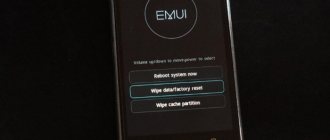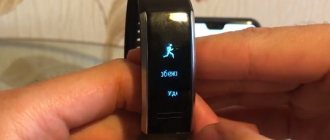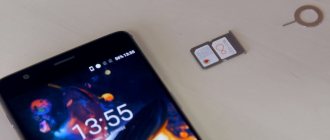Smart features
On the left side panel of Honor 7 there is another completely new Smart Key button for Android smartphone users.
By clicking on it, the user instantly activates his favorite applications. Honor 7 smartphones in Russia come pre-installed with Mail.Ru Group services. A single press opens Mail.Ru Mail, a double press opens the social network Odnoklassniki, a long press opens Mail.Ru News. This feature simplifies and facilitates access to the necessary applications, and the settings allow you to install the three most important programs of the user's choice. In order to take a screenshot of the screen, the smartphone user does not need to press several buttons at the same time - just touch the screen twice with his knuckle. Honor 7 also allows quick access to your favorite applications. To do this, you need to “bind” certain letters to programs once, and then draw them directly on the turned off smartphone screen for instant launch.
https://youtube.com/watch?v=Ljtnybsa0mc
Broadcast of the presentation of Honor 7 in Russia Huawei Device Russia
Use App Lock on Honor 9 Lite
Honor 9 Lite has a built-in application lock, which is system-wide. You can block your apps on Android without downloading third-party blockers. To start using App Lock, go to Settings > Security & Privacy > App Lock. During initial setup, you will be asked to set a password and recovery question, or use a fingerprint. After simple setup, you can block your applications, such as WhatsApp, VKontakte, Odnoklassniki or any other application.
Operating principle of the module
First, it’s worth understanding what NFC is in the Honor 9 Lite smartphone. The technology is designed to transmit small amounts of information in a limited space. The range is only 10 cm, so when making payments or other manipulations with the chip, the device must be touched to the receiver. A system that generates a magnetic field is responsible for the connection. Data transmission is provided via a radio signal at a frequency of 13.56 MHz, which does not interfere with other devices and is considered safe for health.
The presence of NFC in a smartphone opens up the following possibilities:
- contactless payments;
- programming and reading tags;
- transfer files between devices.
Many smartphones from Chinese brands are not equipped with such a chip for a very logical reason. The fact is that China abandoned NFC technology in favor of QR codes. Not all brands care about device buyers living in other countries.
How to make sure that NFC is available on your smartphone?
To check, you can refer to the most reliable source - the official website of the manufacturer. According to current information, in addition to Honor 9 Lite, the module is present in the following devices:
- 7C;
- 8A and 8X;
- 9 and 9X;
- 10 Lite and 10;
- Honor Play.
By the way, there is an NFC antenna in Huawei P9 Lite, a related smartphone. The models are produced for different markets, but technically and externally they are almost identical.
You can also find out if there is NFC by examining the sticker with the model’s characteristics. It is located on the side or back of the box in which the smartphone is supplied. Another way is to launch Settings and enter “NFC” in the search field. If parameters for controlling the module appear among the results, then it is guaranteed to be present in the device.
What payment systems work on a smartphone?
Everything is simple here - Honor 9 Lite, like other devices from the manufacturer, runs on Android OS. Accordingly, Google Pay proprietary technology is used to make payments. It supports almost all Russian banking systems, including Sberbank.
Beginning of work
Unlock with fingerprint
We strongly recommend that you protect your device with a screen lock. Using the fingerprint scanner is a convenient way to unlock it.
However, there are a few points to consider:
- In certain situations, a complex PIN, password, or pattern will protect your phone better than a fingerprint.
- Attackers can use a copy of your fingerprint to unlock your device. Remember that you leave fingerprints on the things you touch (including your phone).
- When setting up the function, you will need to set a backup PIN code, password or pattern. Remember it, as it may be needed, for example, after rebooting the device or in a situation where the fingerprint cannot be recognized.
Where are your fingerprints stored?
Fingerprints are only stored on your device. Neither Google nor the apps have access to this data. Read more…
How to add a fingerprint
- Open your device settings.
- Click Security & Location.
- Select Pixel Imprint or Nexus Imprint.
- Follow the instructions on the screen. If you don't have a screen lock set up, you will be asked to add a backup unlock method - PIN, password, or pattern.
- Scan your fingerprint. Here are some tips:
- Place your finger on the scanner, not on the device screen.
- Hold the phone the way you will hold it when unlocking it (in particular, turn it with the screen facing you).
How to add additional fingerprints
If you want other people to be able to use your phone, add additional fingerprints (up to 5).
Remember that if you add other people's fingerprints, they will be able to unlock and confirm purchases on your account.
- Open your device settings.
- Click Security & Location.
- Select Pixel Imprint or Nexus Imprint.
- Place your finger on the fingerprint scanner or use a backup screen unlock method (PIN, password, or pattern).
- Click Add fingerprint.
- Scan an additional fingerprint.
- To avoid confusion, give your fingerprints names. To do this, tap the fingerprint, enter a new name and press OK.
Note. If more than one person uses your device, they should add fingerprints to their profiles. Read more…
A few more advantages of the fingerprint scanner
Oddly enough, the scanner can be used not only for security purposes, but also for ease of use. Let's look at some interesting options for using the scanner.
Camera button
On smartphones with a fingerprint scanner, the function of capturing when you touch it is enabled by default. This is very convenient for taking selfies, especially if the scanner is located on the back of the smartphone.
Alarm switch
Yes, the alarm can be turned off by simply touching the scanner for a few seconds, very convenient. If you use a third-party alarm clock, you can enable or disable this feature in the settings.
Additional button
On some smartphones, the fingerprint scanner can be used as a "Back" and "Home" button by touching the scanner for 1 or several seconds, respectively.
Design, ergonomics
One of the “features” of Honor 9 Lite, of course, is its appearance, which is perhaps not inferior to the flagship model.
In the metal-glass gadget of its body, the front and back panels are covered with protective 2.5D glass, which smoothly transitions to an aluminum frame around the perimeter. The gadget is offered in three colors – classic black, as well as blue and gray-silver.
With all this, for the last two colors, the rear panel with a special thin-film coating has a “mirror reflection” effect, which provides a certain uniqueness in the appearance of the smartphone - an original play of light on the surface.
An increase in the screen diagonal by half an inch did not lead to significant changes in the dimensions of the Honor 9 Lite, compared to the Honor 9, in terms of (151x71.9 mm versus 147.3x70.9 mm). As you can see, the linear dimensions have grown by less than 3 mm. This is exactly the case when a 5.65-inch “tall” screen fits into the body of a regular 5.2-inch device. And all this thanks to the new aspect ratio of the display. The weight, as if by definition, became a little less (149 g versus 155 g),
and the thickness of the case has remained almost unchanged (7.6 mm versus 7.5 mm).
So, the front panel of Honor 9 Lite is covered with protective glass with a 2.5D effect. Above the display, a decorative speaker grille is surrounded by front cameras and an LED indicator, as well as light and proximity sensors.
The on-screen touch control buttons “Back”, “Home” and “Recent applications” are made with “triangle”, “circle” and “square” icons. Their location can be changed as you please, and also supplemented with another icon (for the notification shade).
The “chrome” Honor logo occupies a small space under the display.
On the right edge of the case there is a volume rocker and a power/lock button that are noticeably different in size.
See also: Budget smartphone Moto E4 appeared on Geekbench
On the left edge there is a closed combination slot with a tray for two places. They can install either two nanoSIMs, or one SIM card and a microSD memory card.
A microUSB connector is located at the bottom end. Let us remind you that Honor 9 uses a more advanced one - USB Type-C. To the right of the microUSB there is a decorative grille for the “multimedia” speaker (there are five round holes), while on the left there is a small hole for the “conversational” microphone, and next to it is a 3.5 mm audio headset connector.
The top end of the Honor 9 Lite is simply empty.
The dual photo module on the rear panel is located a little closer to its upper left edge. To the right of the horizontally located lenses there is a hole for a second microphone (it is used for noise reduction), as well as an LED flash. A little lower, and already in the center, there is a round capacitive fingerprint scanner.
From the inscriptions at the bottom of the back panel, decorated with another Honor logo, you can see the name of the manufacturer, model number and country of manufacture of the device.
The gadget lies quite comfortably in the hand and is in no hurry to slip out of it. However, the Honor 9 Lite comes with a plastic clip case that protects the perimeter and back panel of the case. Of course, all the design features and the mirror effect of the back of the gadget immediately disappear.
Types of fingerprint scanners
The fingerprint sensor is used to unlock the gadget and protect personal data. A special sensor recognizes a complex combination of patterns on the user's fingertip. This pattern is unique for each person and does not change over time. The system determines the fingerprint, compares it with the one stored in the smartphone and thus understands who is holding the device - the owner or some other person, therefore, it is worth opening access to the data or not.
There are three main types of fingerprint sensors:
- optic;
- ultrasonic;
- capacitive.
Optical scanner
Optical scanners are the oldest method of capturing and comparing fingerprints; they are no longer used in modern smartphones. The method is based on capturing an optical image of the fingerprint, which is compared with a sample stored in memory. When characteristic features of the pattern are detected, a decision is made whether the print matches or does not match.
The disadvantage of modules of this type is the low level of security. Since the optical scanner processes a two-dimensional image, it is possible to recreate the owner’s fingerprint using simple manipulations with PVA stationery glue.
Ultrasound scanner
A relatively new type of fingerprint scanner. The technology is based on an ultrasonic transmitter and receiver that transmit and receive an impulse to a finger placed on the scanner. Some of the ultrasound is absorbed, and some returns to the receiver, creating a specific pattern depending on the individual characteristics of the fingerprint. The sound frequency in such scanners is tuned to reflect waves from the human body, which means that it is not yet possible to deceive the sensor by mechanical means - such methods have not yet been found.
At the moment, there are few smartphones with ultrasound scanners - many manufacturers still look at them with caution. The technology is not yet “tested” enough, and implementation is more expensive, which increases the final cost of the devices
Most likely, the ultrasonic module will help launch mass production of smartphones with a scanner built directly into the display - this is the only fingerprint technology that can work through the screen.
Capacitive scanner
A capacitive scanner is the most popular type of module today that recognizes fingerprints in devices. Such fingerprint sensors have found recognition among gadget manufacturers due to the optimal price-quality ratio. They have a low cost and a high degree of protection - of course, it is possible to deceive, but it will be quite difficult to do so.
The technology relies on arrays of tiny capacitor circuits to collect fingerprint data. The module's memory stores information about the electrical charge, and after you place your finger on the module, the values are compared. Therefore, a capacitive scanner cannot be deceived using a dummy.
conclusions
Despite the above functional cuts and simplifications compared to the flagship, Honor 9 Lite has acquired a “high” screen, moreover, it can also boast of its metal-glass body with a “mirror reflection” effect. In addition, the filling of this gadget is worth noting good rear cameras, the presence of an NFC interface, decent sound in headphones, as well as the brand new Android 8.0 operating system immediately upon purchase, which is expanded by the capabilities of the proprietary EMUI 8.0 firmware.
The disadvantages include moderate performance, unimpressive battery life, the lack of a high-frequency Wi-Fi range (5 GHz), as well as the notorious choice between installing a second SIM card and expanding the memory (which, with 32 GB of storage, can already be critical).
The official price of Honor 9 Lite in the company’s online store is 14,990 rubles. For the same or less money in Russian retail you can buy, for example, the following mobile gadgets with a “high” screen - LG Q6α (14,990 rubles), Oppo A83 (13,990 rubles) and Xiaomi Redmi 5 Plus (12,990 rubles, configuration 3 GB/32 GB). True, they all lack camera duos, and the version of the Android operating system is not the latest (but it’s up to updates). So, the LG Q6α, moreover, has a less powerful processor and less memory, except that the viewing angle of the front camera is 100 degrees, and the built-in storage expands up to 2 TB. The Oppo A83 has a disappointing 5.7-inch screen resolution - HD+ (1440x720 pixels). But expanding the built-in memory with microSD cards will not interfere with installing a second nanoSIM card. There is no trace of NFC support in the A83, but there is 2-band Wi-Fi. As for the Xiaomi Redmi Plus with a 5.99-inch screen, it is, first of all, distinguished by a rather capacious battery (4,000 mAh), although without fast charging, and even an IR port for controlling household appliances, well and of course a more attractive price. But the choice, as always, remains yours, dear readers. Do you like Honor 9 Lite?
How to use
Honor 10 contactless payment, as on other gadgets of the company, is carried out as follows:
- Unlock your smartphone using a finger or face scanner.
- Select the desired card in Google Pay.
- Bring the device and make payment.
Thanks to these simple steps, you can make contactless payment.
Bottom line
Honor has a lot of smartphones with a fingerprint sensor. They are presented from the budget segment to the flagships. Thanks to the sensor, you can secure your device, as well as unlock it and log into applications and websites. Some of the company's gadgets also feature face unlocking.
Safety
But is the fingerprint sensor really safe? Yes, cases of fingerprint spoofing on a capacitive module have been documented on the Internet.
However, hacking the sensor requires a combination of skill, knowledge of existing scientific research, and the patience of a forensic scientist.
Experts who managed to bypass the fingerprint protection say that in order to “hacking” a smartphone, it is necessary to identify the required fingerprint used for locking, among many other traces left by the owner of the device. You also need to get a high-quality, clear print of the correct finger - and most often the prints remain a little blurry.
Next you need to “remove” the fingerprint - a task from the realm of criminal investigation experts. You'll have to process it using one of several techniques, including cyanoacrylic fumes and a special powder, before carefully removing the unique pattern using fingerprint tape. It is not simple. Even with a high-quality mark, it's easy to smear the result, and you only have one try: taking a print destroys the original. Further, expensive equipment and special software will be required, which makes the process incredibly complex and costly.
The vulnerability of fingerprint sensors primarily lies in the implementation of the technology by smartphone manufacturers. Fingerprint information is stored in internal memory. The security of the device also depends on how it is protected. In the first devices with scanners, images of users' fingerprints were stored in a shared partition of the file system. It was a simple, unprotected file that could be accessed by attackers.
However, more complex algorithms for storing fingerprint data are now being used. For clarity, let's look at the operation of the modern Honor 9 scanner. To protect information, the manufacturer uses a special technology: it analyzes scanned fingerprints in a separate operating system running on a dedicated virtual processor without access to the main one. As a result, third-party applications and developers cannot access critical data.
Conclusions and general impression of the phone
We've talked about all aspects of this smartphone, so it's time to sum it up. I would like to say right away that the device turned out to be clearly successful. Reading user reviews about this model, it immediately becomes clear that the device was a success. Without exception, all customers liked it.
The developers were able to make a very balanced and powerful device for a really cheap price. If you are looking for a smartphone to surf the Internet and play games, then this will definitely be to your liking, since it copes with all of this with a bang.
We recommend Huawei 9 Lite for purchase.
Pros and cons of the device
To summarize, it is worth clearly highlighting the pros and cons of the device.
Pros:
- High quality screen;
- Great productivity;
- Very good selfie camera;
- The latest version of Android.
Minuses:
- There may not be enough RAM;
- Low battery life.
By purchasing this mobile device, you will get an excellent camera, a game console and a real mini-PC.
What else is a fingerprint scanner used for in smartphones?
In Honor 9, the fingerprint sensor is not only responsible for unlocking the gadget, but also allows you to configure logging into certain applications using your fingerprint. For example, in a gallery with photos, notes or a notebook. Many banking programs also support authorization using a fingerprint: you don’t need to remember long and complex passwords, just put your finger on it.
In addition, in Honor 9, the button with a built-in fingerprint scanner can be used as a navigation panel, controlling the smartphone with gestures. Pressing the key takes you back one step, a long tap takes you to the desktop, and a swipe to the left launches the last open applications. If you don’t like this control method, you can always return to the standard “three-button” mode by selecting the appropriate item in the settings.
Screen
For the fleshed-out version of the flagship Honor 9, the display diagonal size has been increased from 5.15 inches to 5.65 inches. At the same time, the matrix technology from LTPS has returned to conventional IPS. Since the screen itself was “stretched” in the proportion 18:9 (it was 16:9), its resolution increased from Full HD (1920x1080 pixels) to Full HD+ (2160x1080 pixels), while the dots per inch density remained the same - 428 ppi. Let us remind you that Huawei calls a display with an increased screen-to-front panel ratio FullView.
The results of the AnTuTu Tester application show and confirm up to ten simultaneous presses on the touch screen. The backlight level can be adjusted either manually or o. Enabling full-screen mode allows you to stretch “part-screen” applications across the entire display.
Using the color wheel with two presets in the Display settings, you can change the color temperature, making images warmer or cooler at your discretion. The vision protection mode reduces the level of ultraviolet radiation, which helps relieve eye fatigue, while the color temperature can be adjusted independently. Instead of the maximum Full HD+ resolution (2160×1080 pixels), it’s easy to select a lower resolution in the settings – HD+ (1440×720 pixels). This solution has a positive effect on energy saving. A high-quality oleophobic coating, on which the finger glides very easily, allows you to remove small dirt and fingerprints on the protective glass with a 2.5D effect without any effort.
Ready for any challenge
The smartphone is powered by an eight-core HiSilicon Kirin 935 processor with big.LITTLE architecture. The chipset consists of 4 cores with a clock frequency of 1.5 GHz, active during simple tasks like web surfing or working with mail, and 4 high-performance cores with a frequency of 2.2 GHz for resource-demanding programs. The chipset also includes a Mali-T628 MP4 graphics accelerator, and 3 GB of RAM are responsible for multitasking and smooth operation of all elements of the EMUI 3.1 user interface.
To store user content, Honor 7 has 16 GB of internal memory, but this volume can easily be expanded by installing a microSD card up to 128 GB. The battery capacity is 3000 mAh.
The Honor 7 screen is great for work, entertainment and communication via video messengers. Its diagonal is 5.2 inches and is based on an IPS matrix with excellent color reproduction, wide viewing angles and a resolution of 1920×1080 pixels.
Software Features
Right out of the box, the Honor View 10 smartphone runs Android 8.0 (Oreo), the interface of which is hidden behind the proprietary EMUI 8.0 shell. This launcher offers a choice between a regular home screen style and a style with a separate application menu (screen).
In addition to the control panel with four icon combinations, you can use the button of the same name for system navigation. This “navigation button” can be easily placed in a convenient location on the screen, while the icons on the control panel can be completely hidden.
The EMUI 8.0 launcher allows, for example, to activate HD screencast (video recording from the screen, 1280x640 pixels), quickly change the working display size, and also make input easier by moving the virtual keyboard.
A tap and hold on the “Recent Applications” button divides the gadget screen into two parts to simultaneously display the operation of some pairs of programs. But tapping and holding on the program icon displays an access menu with frequently used (up to four) functions of this application. With the next tap and hold, on the line of the menu that appears, you can easily move the icon of one of these same functions to the main screen. For example, to open the “Camera” application with the “Wide Aperture” or “Selfie” mode activated. Searching for apps, contacts and messages opens by swiping down from the top of the home screen.
According to what is written in the passport, the fingerprint scanner unlocks the gadget in a quarter of a second. In addition, after registering (up to five) fingerprints, it is easy to increase the level of security for access to personal data folders and applications. At the same time, the scanner’s touch pad will help you answer voice calls, turn off the alarm, open the notification panel, scroll through images, and activate photo or video shooting from the Camera application. Fingerprint registration is not required.
Freedom of creativity
With Honor 7 you can take great photos even in low light conditions. The main camera of the smartphone is equipped with a 20 MP sensor and supports PDAF technology, which in most cases reduces the focusing time to 0.1 seconds. The camera lens is reliably protected by scratch-resistant sapphire glass, and the f/2.0 aperture makes it possible not to use the built-in flash even in the dark.
For creative users, Honor 7 offers a lot of interesting shooting modes, including a new feature this year – light painting mode. With its help, for example, it is very easy to capture the streaks of light that remain on the track when shooting with a long shutter speed. In addition, the user can always change all basic settings manually.
The front 8-megapixel camera of Honor 7 with f/2.4 aperture is also equipped with a built-in flash. You can take great selfies with it. The decoration mode will undoubtedly appeal to girls, and the function of shooting panoramic self-portraits will help you take memorable selfies with friends.
Cameras
Unlike the flagship gadget, Honor 9 Lite has two camera duos with pairs of identical sensors. So, in the rear photo module with an LED flash, the 13-megapixel main camera, which is responsible for shooting, received a lens with phase detection autofocus and an f/2.2 lens aperture. In turn, the 2-megapixel auxiliary sensor determines the depth of field, which is needed for wide aperture mode and shooting portraits. In the front photo module, the aperture of the main lens is already f/2.0, and instead of a flash, you can use the screen backlight (which is no good, but still a solution).
The maximum image resolution for the main camera is 4160x3120 pixels (13 MP) with an aspect ratio of 4:3. Additionally, there is the possibility of shooting with frame proportions 1:1 (3104x3104 pixels, 10 MP) and 18:9 (4160x2080 pixels, 9 MP).
For both cameras, the maximum video resolution is Full HD (1920x1080 pixels, 16:9) with a frame rate of 30 fps. Interval shooting (“Time Lapse”) is supported only in HD quality (1280x720 pixels). Content is saved in MP4 container files (AVC - video, AAC - audio).
In the Camera application interface, you can swipe left to open the settings panel, and swipe right to open a list of shooting scenarios, including professional (photo and video), panoramic, HDR, etc. modes, including "Filters". In the professional photo mode, there is manual adjustment of settings such as exposure metering method, ISO and shutter speed, exposure compensation level, focusing method, and also white balance. For the rear duo of cameras in wide aperture mode, the value of the emulated aperture can be changed from 0.95 to 16. For the front photo module, we limited ourselves to activating the “blur effect” setting.
See also: Setting up NFC for contactless payment on Huawei gadgets?
In the portrait mode of the rear photo module, you can select the “decoration effect” in the range from 0 to 10, and also enable or disable the “blur effect” option (resolution 3264x2448 pixels, 8 MP). In the “live photo” mode, along with the photo, accompanying short clips are recorded, which can only be viewed in the standard “Gallery”. For proprietary artistic shooting modes “Light” you need to use a tripod. Examples of photos from the main camera can be found on Google Photos.
Solution
If it was not possible to enter new data into the phone, the algorithm of actions is as follows:
- go to general phone settings;
- tap on the line “Advanced settings”;
- go to the “For Developers” section;
- in it, disable the custom mode by moving the slider.
This method works in 7 out of 10 cases. But if the problem cannot be solved, all that remains is to reset the gadget to factory settings.
Removing an old fingerprint and adding a new one
This manipulation is also performed in the settings. The procedure for removing the old sample is very simple and takes only a couple of minutes.
- Open Screen Lock & Fingerprint.
- Enter password.
- Click on "New Password".
- Confirm deleting the current lock key.
Algorithm for adding a new lock key:
open “System and Device”;
- tap on “Lock screen and fingerprint”;
- go to the “Screen lock and fingerprint” section;
scroll to the bottom and click “Add”;
- in case of a bug, enter another pattern key or PIN;
- apply the same finger several times in different positions;
- wait for vibration.











